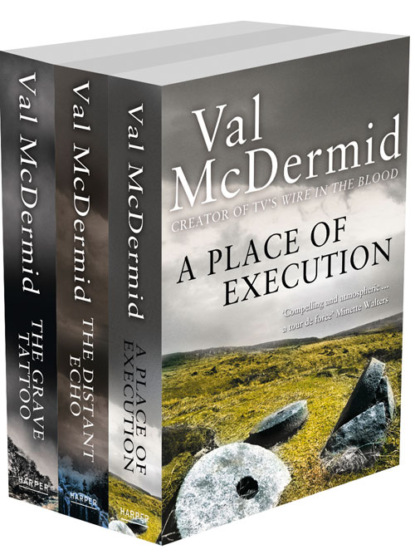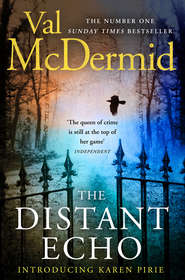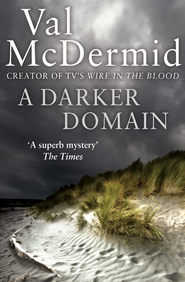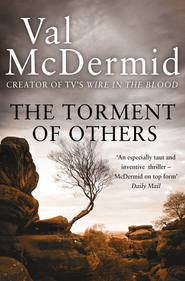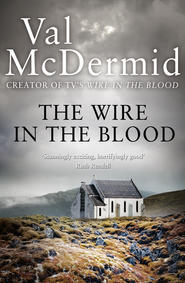По всем вопросам обращайтесь на: info@litportal.ru
(©) 2003-2024.
✖
Val McDermid 3-Book Crime Collection: A Place of Execution, The Distant Echo, The Grave Tattoo
Автор
Год написания книги
2018
Настройки чтения
Размер шрифта
Высота строк
Поля
PART THREE (#litres_trial_promo)
Chapter 1 (#litres_trial_promo)
Chapter 2 (#litres_trial_promo)
Chapter 3 (#litres_trial_promo)
Chapter 4 (#litres_trial_promo)
Chapter 5 (#litres_trial_promo)
Chapter 6 (#litres_trial_promo)
Chapter 7 (#litres_trial_promo)
Chapter 8 (#litres_trial_promo)
Chapter 9 (#litres_trial_promo)
Chapter 10 (#litres_trial_promo)
About the Author (#litres_trial_promo)
By the Same Author (#litres_trial_promo)
Copyright (#litres_trial_promo)
About the Publisher (#litres_trial_promo)
Epigraph (#ulink_f2c124f1-9775-586c-8c85-72a8d197bf78)
You shall be taken to the place from whence you came, and thence to a place of lawful execution, and there you shall be hanged by the neck until you be dead, and afterwards your body shall be buried in a common grave within the precincts of the prison wherein you were last confined before your execution; and may the Lord have mercy on your soul.
The formal death sentence of the English legal system
LE PENDU: THE HANGED MAN
Divinatory meaning: The card suggests life in suspension. Reversal of the mind and one’s way of life. Transition. Abandonment. Renunciation. The changing of life’s forces. Readjustment. Regeneration. Rebirth. Improvement. Efforts and sacrifice may have to be undertaken to succeed towards a goal which may not be reached.
Tarot Cards for Fun and Fortune Telling S. R. Kaplan
BOOK 1 (#ulink_45c4c29f-896a-5e1e-a858-16bb2dbca868)
Introduction (#ulink_f96d26fd-5def-5cc3-9df8-63ca1af729db)
Like Alison Carter, I was born in Derbyshire in 1950. Like her, I grew up familiar with the limestone dales of the White Peak, no stranger to the winter blizzards that regularly cut us off from the rest of the country. It was in Buxton, after all, that snow once stopped play in a county cricket match in June.
So when Alison Carter went missing in December 1963, it meant more to me and my classmates than it can have done to most other people. We knew villages like the one she’d grown up in. We knew the sort of things she’d have done every day. We suffered through similar classes and cloakroom arguments about which of the Fab Four was our favourite Beatle. We imagined we shared the same hopes, dreams and fears. Because of that, right from the word go, we all knew something terrible had happened to Alison Carter, because something we also knew was that girls like her – like us – didn’t run away. Not in Derbyshire in the middle of December, anyway.
It wasn’t just the thirteen-year-old girls who understood that. My father was one of the hundreds of volunteer searchers who combed the high moorland and the wooded valleys around Scardale, and his grim face when he returned home after a fruitless day scouring the landscape is still sharply etched in my memory.
We followed the hunt for Alison Carter in the newspapers, and every day at school for weeks, someone would be bound to start the speculation rolling. All these years later, I still had more questions for George Bennett than the former policeman could answer.
I have not based my narrative solely on George Bennett’s contemporaneous notes and current memories. While researching this book, I made several visits to Scardale and the surrounding area, interviewing many of the people who played a part in the unfolding of Alison Carter’s story, gathering their impressions, comparing their accounts of events as they experienced them. I could not have completed this book without the help of Janet Carter, Tommy Clough, Peter Grundy, Charles Lomas, Kathy Lomas and Don Smart. I have taken some artistic licence in ascribing thoughts, emotions and dialogue to people, but these sections are based on my interviews with those of the surviving protagonists who agreed to help me to try to create a truthful picture both of a community and the individuals within it.
Some of what happened on that terrible December night in 1963 will of course never be known. But for everyone who has ever been touched, however remotely, by Alison Carter’s life and death, George Bennett’s story is a fascinating insight into one of the most heartless crimes of the 1960s.
For too long, it has remained hidden in the shadow of the understandably more notorious Moors Murders. But Alison Carter’s fate is no less terrible for coming at the hands of a killer who had but a single victim. And the message of her death is still as important today. If Alison Carter’s story tells us one thing, it is that even the gravest of dangers can wear a friendly face.
Nothing can bring Alison Carter back. But reminding the world of what happened to her might prevent others coming to harm. If this book achieves that, both George Bennett and I will feel some satisfaction.
Catherine Heathcote Longnor, 1998
Prologue (#ulink_440dce5f-d5bc-5ebd-80a6-de25a4b75ded)
The girl was saying goodbye to her life. And it was no easy farewell.
Like any teenager, she’d always found plenty to complain about. But now that she was about to lose it, this life suddenly seemed very desirable. Now at last she began to understand why her elderly relatives clung so tenaciously to every precious moment, even if it was riven with pain. However bad this life was, the alternative was infinitely worse.
She had even begun to regret things. All the times she’d wished her mother dead; all the times she’d wished that her dream of being a changeling would come true; all the hate she’d expended on the children at school who had called her names for not being one of them; all the fervent longings to be grown up, with these miseries behind her. It all seemed irrelevant now. The only thing that mattered was the uniquely valuable life she was about to lose.
She felt fear, inevitably. Fear of what lay beyond as well as what lay immediately ahead. She’d been brought up to believe in heaven and in its necessary counterweight, hell, the equal and opposite force that held things stable. She had her own very clear ideas of what heaven would be. More than she had ever hoped anything in her short life, she hoped that that was what lay in wait for her, so terrifyingly close now.
But she was desperately afraid that what she was going to was hell. She wasn’t so clear about what hell would consist of. She just knew that, compared to everything she’d hated about her life, it would be worse. And given what she knew, that meant it was going to be very bad indeed.
Nevertheless, there was no other possible choice for her. The girl had to say goodbye to her life.
For ever.
PART ONE The Early Stages (#ulink_d5c7815d-f855-5dbc-8807-5bc00e4ffe25)
Manchester Evening News,
Tuesday, 10
December 1963, p. 3
£100 reward in boy hunt
Police continued to hunt for 12-year-old John Kilbride today – and hoped that a £100 reward might produce a new lead.
For a local managing director has offered £100 to anyone who gives information which leads directly to the discovery of John who vanished from his home in Smallshaw Lane, Ashton-under-Lyne 18 days ago.
1 (#ulink_696dd7bf-b062-56c3-b25a-82921f05acc8)
Wednesday, 11
December 1963. 7.53 p.m.





